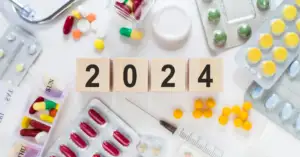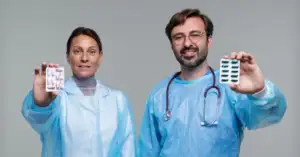As per the treatment compliance medicines are required to be taken during daytime by the advice of the clinician. Some of the medicines require multiple intakes during the daytime. This often becomes a burden for the caregivers and the patients as many times patients forget to take the medicines. The frequency of the intake of the medication without disturbing the therapy’s effectiveness directed to the timely released forms of dosage development recognized with various terminologies. The pharmaceutical field has been revolutionized by the sustained release dosage forms as their approach is sophisticated to the delivery of a drug. These formulations are also known as controlled release dosage forms or extended-release dosage forms and are tailored in such a way so that they steadily release therapeutics into the body over a prolonged interval and ensure a better therapeutic effect unlike traditional methods. This invention not only enhances convenience of a patient as they have to use reduced frequency of dosage but also potentially offers better outcomes of treatment by keeping the levels of the drug for long intervals in the therapeutic limit.
Sustained release dosage forms are increasingly being used in global clinical trials to assess their efficacy and safety across diverse patient populations. These global clinical trials aim to evaluate the performance of sustained release formulations in maintaining therapeutic drug levels and improving patient adherence in various regions worldwide. Clinical trials globally also help in the identification of any differences specific to region pertaining to sustained release dosage forms, notifying regulatory decisions and strategies of access to markets. Investment in R&D is made by pharmaceutical manufacturers for the development of sustained release dosage forms, targeting to advance efficacy of a drug and patient adherence. Special knowledge is required by the pharmaceutical manufacturers for the designing and manufacturing of these dosage forms like advanced techniques of coating and systems of controlled release. Adherence to strict regulatory measures must be followed by pharmaceutical manufacturers for ensuring the quality, safety, and efficacy of dosage forms, frequently involving extensive analysis and documentation.
Types of Sustained Release Dosage Forms:
- Extended Release Tablets/Capsules:
- These are the most common form of sustained release dosage forms.
- Their design is made in such a way that the drug is gradually released over a lengthy period, often through matrix systems or unique coatings.
- Patients should know that these tablets are not chewable or for crushing, as it leads to disruption of the controlled-release mechanism leading to release of the drug rapidly and unintentionally.
- Examples are namely OxyContin (oxycodone), Glucophage XR (metformin), and Concerta (methylphenidate).
- Sustained Release Matrix Systems:
- These systems comprise of uniform distribution of the drug within a reservoir or matrix.
- The release of the drug takes place by diffusion through the matrix or over the time matrix erosion.
- Examples include certain types of oral tablets and capsules.
- Osmotic Pump Systems:
- These systems release the drug at a controlled rate using osmotic pressure.
- There is a membrane semi-permeable in nature in the device that allows the entry of water, thrusting the drug out through a minute opening.
- Examples are namely Osmolex ER (amantadine), and Procardia XL (nifedipine).
- Coated Beads or Granules:
- The drug is contained within coated beads or granules.
- Over time the drug is released from each of the granules or beads granting a sustained effect.
- Examples are namely Ritalin LA (methylphenidate) and Adderall XR (mixed amphetamine salts).
- Transdermal Patches:
- These require skin application, and the drug is delivered over a prolonged time through the skin into the blood.
- They are often utilised for drugs that can undergo skin absorption.
- Examples are namely nicotine patches for cessation of smoking and the fentanyl patch for relief from pain.
- Implants:
- These are tiny devices implanted beneath the skin that release the drug slowly over weeks, months, or even years.
- They are used often for hormonal therapies, such as contraceptives (e.g., Nexplanon) or for disorders like advanced cancer of the prostate (e.g., Zoladex).
Sustained Release Dosage Forms has several advantages as depicted below:
- Reduced Administration Frequency: There is an improvement in compliance, especially in long lasting treatments as the medications can be less frequently taken by the patients.
- Consistent Levels of Drug: These formulations maintain the lengthier duration of the concentration of the drug within the therapeutic range lowering variabilities.
- Side Effects Reduction: By the avoidance of high peaks in the concentration of a drug, side effects can be potentially reduced by these formulations.
Pharmacotherapy has sustained release dosage forms as useful tools, which offers advantages like improvement in patient adherence, side effects reduction, and more stability in the levels of drug. These dosage forms fall under prescription products and must be taken only under the treating physician’s supervision.





